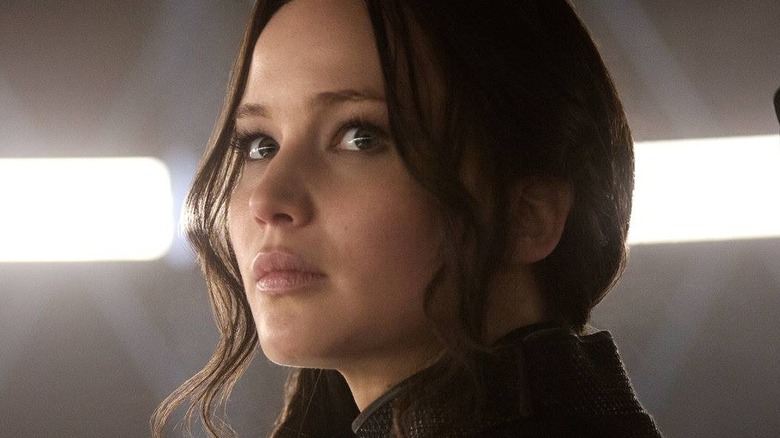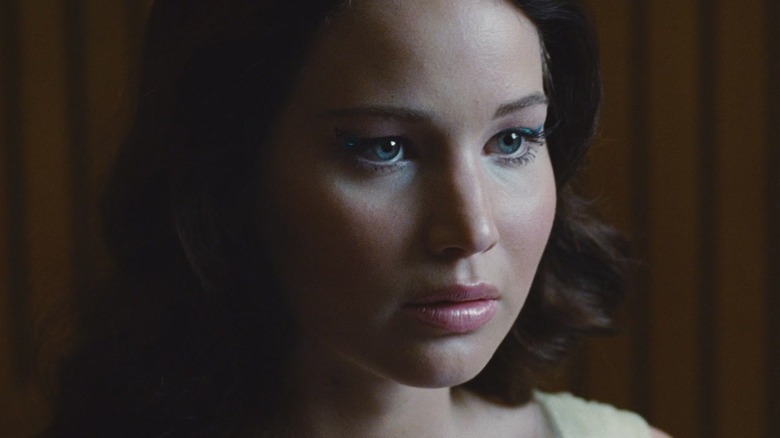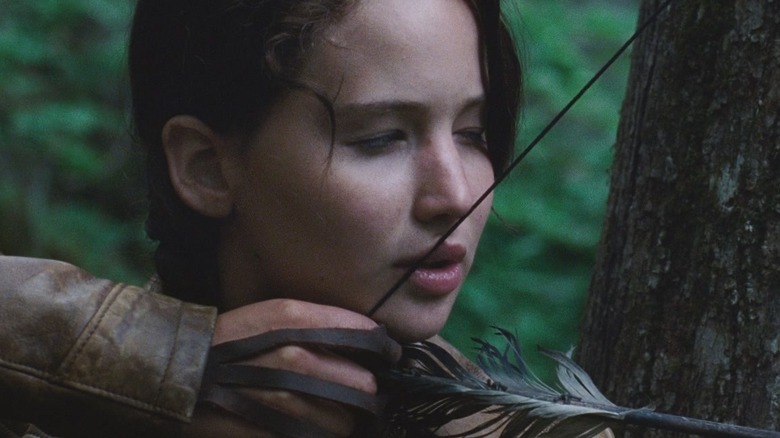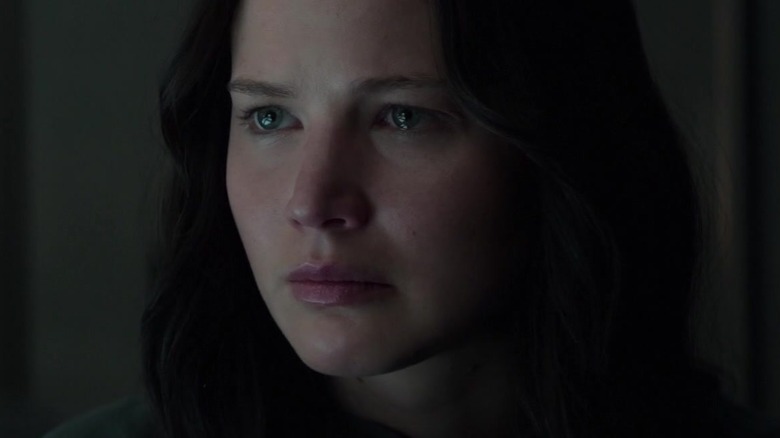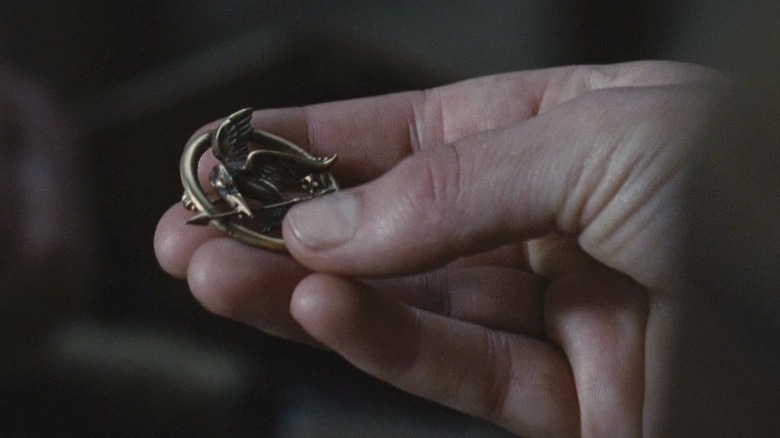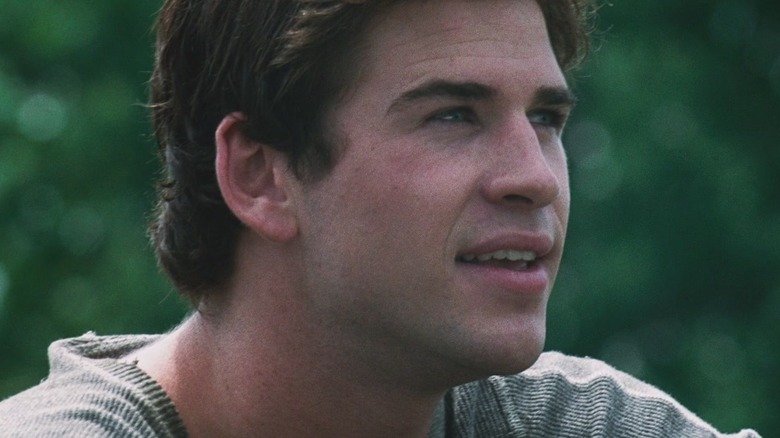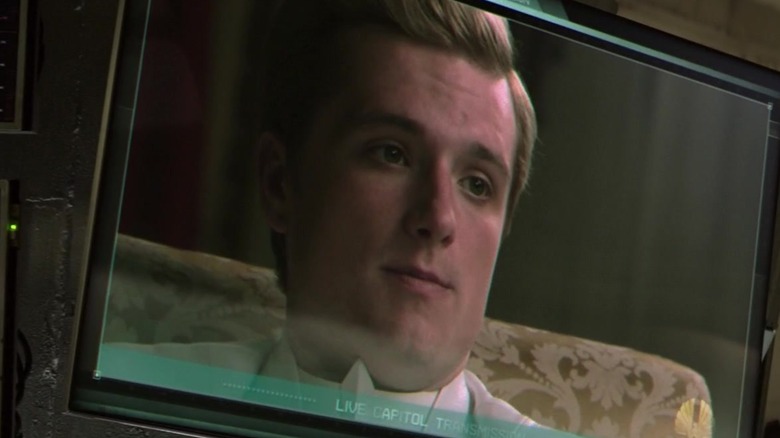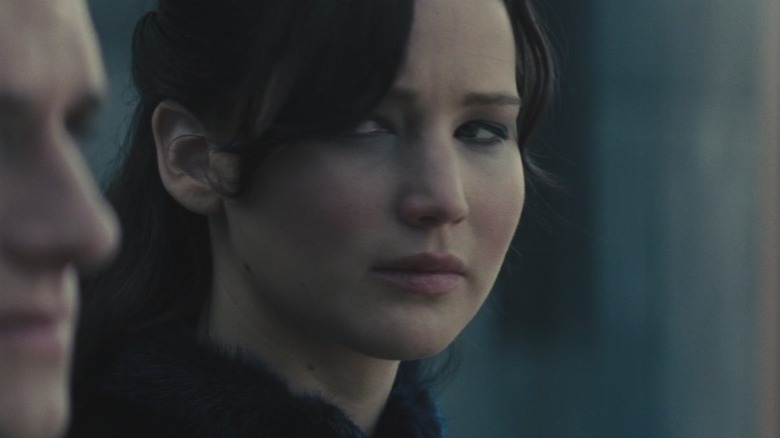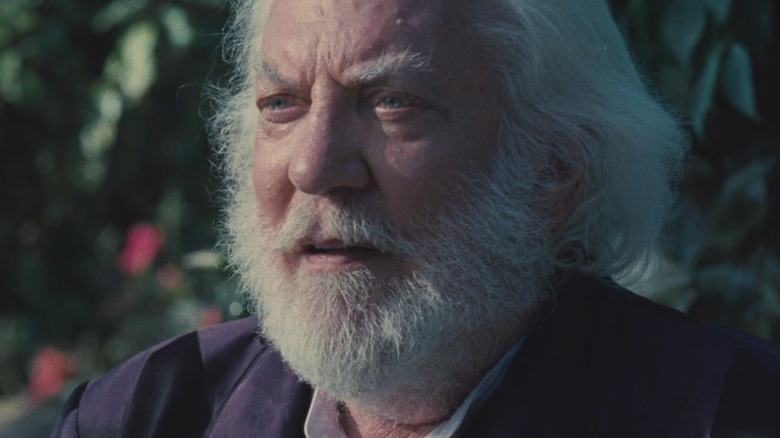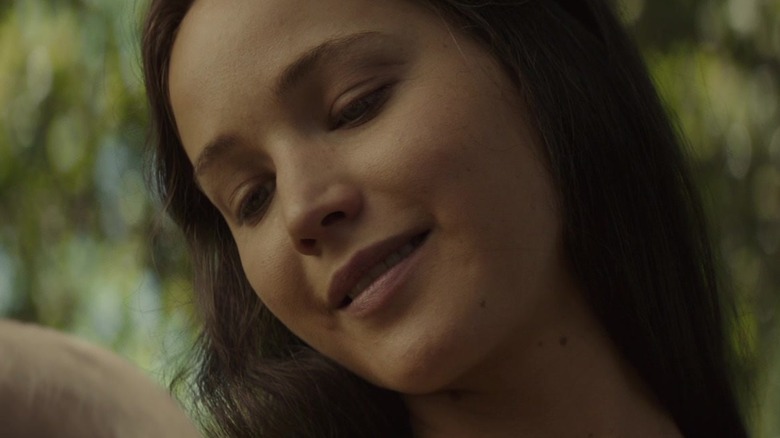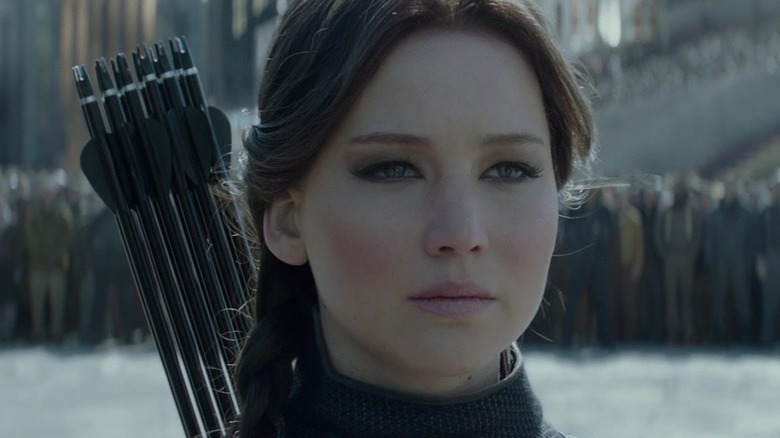The Captivating History Of The Hunger Games' Katniss Everdeen
"The Hunger Games," the young-adult dystopian book series that took readers by storm, has plenty of fascinating characters within its pages. In particular, the story features several strong women, like Johanna Mason, a victor from District 7, and President Alma Coin, the leader of the still-alive District 13. The one that obviously stands out, though, is Katniss Everdeen, the main character and narrator of the series.
The teen archer makes her mark on the Capitol, stealing hearts when she volunteers for the Games in place of her sister Primrose and giving them a love story for the ages with her fellow tribute Peeta. What starts as an effort to survive the Games and return home to District 12, however, turns into the young woman becoming the face of a nationwide rebellion she didn't mean to ignite.
Katniss may be known as the Girl on Fire, but there is much more to her than what she shows the districts on her Victory Tour. Get ready to watch on as we share everything you may not know about her.
How the character came to be
Collins had the idea for a story about a dystopian world before she developed the character it's known for. "Katniss appeared almost immediately after I had the idea," she shared with the New York Times in 2018. "[She was] standing by the bed with that bow and arrow." The author went on to discuss how she decided on the teen's iconic weaponry. While writing her other series, "The Underland Chronicles," she was always "weighing the attributes of different weapons." She didn't use bows often in those books because of the environment she created.
The archer's name came while she was conducting research for "The Hunger Games." She found the arrowhead plant and felt it mirrored the character growing in her head. In looking at the other names of the plant, other potential options were swamp potato and duck potato. "Katniss easily won the day."
Collins hadn't intended to write the trilogy in the first person, either. Like "The Underland Chronicle," she planned to write her next series in the third person. When she sat down to actually write it though, Katniss took over. "I sat down to work and the first page poured out in first person," the author continued. "She was saying, 'Step aside, this is my story to tell.' So I let her."
Who taught Katniss archery
While the author hadn't used archers in her first series, they became a central focus in "The Hunger Games." Katniss didn't teach herself archery; she learned from her father, who is never given a name in the books or films. Though he worked in the mines like many adults in District 12 did, he wasn't paid enough to keep food on the table. To ensure he and his family would be fed, he hunted in the woods near the district.
Sometimes he'd take Katniss with him, showing her which plants were safe to eat and how to hunt with a bow. In these outings with her father, she was learning crucial skills that other children her age weren't privy to. He'd even take her to a lake that was deep in the trees, teaching her how to swim and where to forage for edible plants.
These skills proved beneficial for Katniss when she was in the Games. In her first Games, the 74th, she used these skills to feed and fend for herself, while the ability to swim came in handy during the opening sequence of the 75th, the Quarter Quell..
How she saved her family
At age eleven, Katniss' father passed away in a tragic mine accident. An explosion caused the death of many workers from District 12, including Katniss' father and Gale's father. "There was nothing to even bury," the teen says in "The Hunger Games." His death meant her family now consisted of her, her mother, and Primrose, and they did not have a breadwinner.
Her mother fell into a significant depression after her husband's death. When they were married, she left her life in the more well-off part of District 12 to move to the Seam, the poorest area of the district, showing just how much she cared for him. The depression continued in the years that followed, making it difficult for her to be maternal. This left Katniss as the only person to take care of her younger sister and ensure the family would survive.
At a young age, she utilized the hunting skills her father taught her to support her family and prevent starvation. The tween didn't realize right away that she could go down that avenue, but once she did she was able to keep her family fed and pick up where her father left off. As the stories begin, Katniss ventures further and further into the woods, using her bow to catch game. Some is for her family to consume, and some is used to trade or to sell to maintain a steady income. Everyone purchases meat and plants from her, including the mayor of District 12, Mayor Undersee.
How she gets her iconic Mockingjay pin
Fans of the films may think they know how Katniss received her iconic mockingjay pin, but the movie actually depicts it differently than the book. In the first film, Katniss is in The Hob, the District 12 black market, on the morning of the reaping. While trading for a ball of yarn with Greasy Sae (Sandra Ellis Lafferty), an older woman, the teen sees the pin. When she asks for the price, the old woman tells her she can have it. Katniss proceeds to give it to Primrose (Willow Shields), meant as good luck for her first reaping and "so nothing bad will happen to [her]." After she volunteers in Prim's place, her sister gives it back during their goodbye.
Katniss acquires the pin a bit differently in the book. After the reaping, several members of the town come to send Katniss off. Besides her family and Gale, Peeta's father and Madge Undersee, the daughter of the mayor, come. While Mr. Mellark assures the teen he won't let Prim starve and gives her cookies, Madge brings a gift that will later turn into the symbol of the rebellion, asking Katniss to wear the pin as her district token in the arena.
Her complicated relationship with Gale
Before her first Games, Katniss' best friend is Gale Hawthorne. He was two years older than her, but they both experienced the same loss: his father died in the same mine accident as Katniss'. The two work together to provide for their families, hunting and trading to ensure neither starves.
This relationship becomes slightly strained, however, after she wins the Hunger Games. In "Catching Fire," he admits he is in love with her, even though she can't return his ardor. Gale even notes it would be better if Peeta was easier to hate, clearly jealous of how the two interacted in the arena. After the twist to the 75th Hunger Games is announced — that is, bringing former victors back into the arena — Katniss realizes that she does love him, but it is in a "limited way." While she intends to tell him this during their goodbye after the reaping, Peacekeepers prevent her from seeing anyone.
Ultimately, the two reunite in District 13 in "Mockingjay." They grow closer again, but Gale's involvement with the rebellion and his work with President Coin causes problems between them. Katniss questions why Gale won't share information with her, while he realizes that his friend only looks at him when he is in pain. This relationship only worsens when she realizes he is likely involved with the bomb that killed Prim. She recognizes that something would've always forced them apart because they had similar personalities, and it was best to let him go rather than try and disassociate him from her sister's death.
The Capitol recognizes the influence she has
Anyone with power in "The Hunger Games" series recognizes the influence Katniss has over Panem, even if she doesn't know it at first. President Snow recognizes what her actions could do right away. He has Seneca Crane, the Head Gamesmaker, killed because he was manipulated by the District 12 tributes and allowed them to leave the arena alive as victors in the 74th Hunger Games. This action, though not meant as an act of defiance, is taken as one by some districts and encourages acts of rebellion across the country.
After the 75th Hunger Games, the Capitol continues to try and prevent her image, and the ideas that come with it, from reaching the country's citizens. They know she is the person to turn the tide. If they can make her put down her arms and give up the fight, the rest of the rebellion will follow. The Capitol tries to use Peeta to make this happen, filming addresses where he asks Katniss to reconsider what's happening and to question the intentions of the people around her. Their goal in using Peeta is to break her spirit, which would do the same to the rebels.
The fate of the country is on her shoulders
President Snow makes it clear to Katniss that it is her responsibility to quell any inklings of uprisings in the districts. Before she leaves on the Victory Tour in "Catching Fire," he meets with her to explain the dilemma. Citizens took her actions at the end of the Games, particularly her willingness to die with Peeta rather than kill him, as an act of defiance.
Her goal is simple: make everyone believe she behaved the way she did because of how in love with Peeta she is or President Snow will hurt her and Gale's families. Unfortunately, even with a surprise marriage proposal, she doesn't quench the fire she started. In District 11, home of Rue, one of the tributes Katniss befriended in the arena, a man whistles the tune their female tribute used in the ring. It causes everyone in the crowd to use the District 12 salute and results in three deaths.
After the 75th Hunger Games, the fate of the rebellion, and the future of the country, falls on her shoulders. She is the face of the movement, having to go out to the districts and film propaganda videos. Katniss is also the one chosen to kill President Snow in the final moments of "Mockingjay," showing just how much pressure Katniss is constantly under.
Who she reminds President Snow of
In "The Hunger Games" prequel "The Ballad of Songbirds and Snakes," readers learn about the early life of Coriolanus Snow, the gentleman they were initially introduced to as President Snow. The prequel follows him as he becomes a mentor in the 10th Hunger Games and tries to secure a scholarship for college. Snow and his family are poor, having lost most of their wealth when District 13 was bombed during the first war, so his only way to secure a scholarship is to do well as a mentor. Much to his dismay, he is assigned the female tribute from District 12, considered the worst tribute.
However, we finally learn why Snow is wary of Katniss. Lucy Gray Baird had the same influence over Panem as Katniss... just through different means. Lucy Gray sings a song after she was reaped, which makes her stand out and puts her mentor in a compromising position. The influence she has over him, to the point that he believed he was in love with her, made him want her survival for emotional reasons rather than just to ensure his place in society.
Both are female tributes from District 12 who unintentionally connected with the citizens of Panem. Like Katniss with the berries, Lucy Gray used one of the Capitol's weapons, mutated snakes, to her own advantage. The only difference is Snow recognizes that Katniss' actions combined with her connection could start an uprising that would burn fast. While Lucy Gray mainly influenced Snow, Katniss could influence an entire country, and the President can't have that.
She likely suffers from PTSD
Psychiatrists do believe the character meets the five criteria to be diagnosed with PTSD. Based on how Katniss is portrayed in the films, Dr. Vasilis K. Pozios and Dr. Praveen R. Kambam write that it isn't a "surprise," considering everything she's been through (via WIRED).
After her first time in the Hunger Games, Katniss struggles with nightmares surrounding the trauma she experienced. They typically show other tributes or obstacles she faced, like the mutts with the dead tributes' eyes. These nightmares continue on the Victory Tour, which results in Peeta spending nights with her to give her comfort.
When it's announced that the 75th Hunger Games will put her back in the arena, Katniss lashes out. She winds up in the cellar of an empty home, screaming until her voice is strained. After tiring herself out, Katniss heads to Haymitch's home and two drink together, wallowing in what will happen and making a pact to save Peeta. Her second Games is worse, with a plan in action that she isn't aware of until after the fact. She goes through being blasted out of the arena and carried off to District 13 while Peeta is kidnapped by the Capitol.
Katniss only continues to experience trauma in "Mockingjay." Having to mourn the death of her sister strikes a chord, especially when she realizes Gale may have been involved. In the epilogue, Katniss says her nightmares "won't ever really go away," meaning her mind is still scarred from what she went through.
How she heals after the war
Despite the trauma she experiences, Katniss does manage to heal some after the war. After facing trial for killing President Coin, she's released and confined to District 12, or what's left of it. Peeta returns several days later. With the help of Dr. Aurelius, a doctor that took care of her, she beings to come to the surface, implementing a routine to help ground herself. She continues to hunt, returning to an old hobby, and tries to make a new life.
With the help of those around her, she makes a book of the fallen. Other tributes, her family members, and people they knew from the Games are included, with photos and memories penciled in. Katniss ensures that the people lost because of the Games won't be lost to time. She and Peeta settle into a life together, rekindling their romantic relationship. The two eventually have children, opting to stay in District 12, which has pivoted from mining coal to producing medicine. While their daughter knows they had a role in the war, they haven't shared everything with her yet, though they plan to.
In "Mockingjay," Katniss says that on bad days she "makes a list in [her] head of every act of goodness [she's] seen someone do." It helps when the nightmares make it hard to enjoy life. While she notes it can get a bit "tedious," it gives her comfort.
What the character represents
Katniss Everdeen is a hero, but not in the traditional sense. "Collins challenged our ideas of what a hero should be," Madeleine Deliee wrote for Shondaland. "Not only does a protagonist not need to be superhuman — she showed us it's better if they're not." Katniss is flawed but realistic; readers see her in states of vulnerability, but also in times of strength and courage.
She also encourages readers to think about the world around them and their place within their community, something that pushed the young-adult genre in a new direction. "Not only did Collins subvert YA expectations," the article continued. "She led readers and future writers to look more closely as well." Author Nicky Drayden believes that the character and series expose the next generation to the idea "that the world doesn't really care about young people," a strong statement regarding the sociopolitical climate of the United States.
Jennifer Lawrence was frustrated by the character at first
Gary Ross, the director of "The Hunger Games," knew Jennifer Lawrence was going to be the perfect Katniss after her audition. "She came in and read for me and it just knocked me out," he shared with Entertainment Weekly. "We did a scene from the movie and it was so amazingly powerful that it was sort of stunning." Suzanne Collins showed her approval in a casting announcement letter archived by Entertainment Weekly, noting "I watched Jennifer embody every essential quality necessary to play Katniss."
While the director and author were in agreement, Lawrence almost didn't take the role. She knew joining the project "could completely change [her] life," especially as she was known for doing independent films (via USA Today). Her mother convinced her to do it, reminding her daughter that she always said the size of the movie didn't matter. "I wanted to play this character. I was scared of the aftermath, but you can't say no to things because you're scared," Lawrence detailed to USA Today. "You just have to go for it."
She enjoyed the role, but was frustrated by Katniss' "reluctance." During the premiere of "The Hunger Games: Mockingjay — Part 2" in New York City, Lawrence discussed the character and that she didn't realize her true nature until she was older. "I want her to take this leadership," the actress shared (via ABC News). "It wasn't until I got older that I was like, no, that is a true warrior and a true hero who knows the consequences of war."
